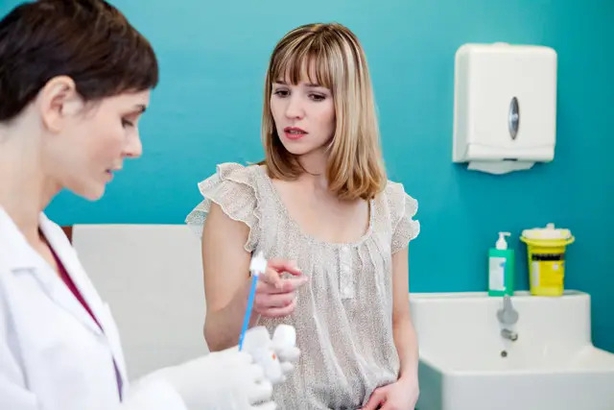Remember, if you’re worried or unsure about anything when it comes to your health, it is always absolutely OK to ask healthcare professionals for more information.
You can also find more information on HPV screening on HSE.ie.
Who can apply for a HPV test?
Women and people with a cervix between the age of 25 and 65 should go for regular cervical screening when it's due.
What happens if HPV is found in a test sample?
If HPV is found, the same sample will be looked at by a minimum of two specialist screeners, for abnormal cells. In some cases, your sample may also be reviewed by a pathologist. If HPV is found and no evidence of abnormal cell changes, you will be called back for a test in 12 months to see if the virus is still present.
If HPV is not found, you will be called back for your next test in either three or five years (or sooner, depending on your personal screening history). If HPV is not found, the risk for developing abnormal cells that could lead to cancer is very low.
Why is HPV screened?
A test showing that you do not have a HPV infection is more reliable than a test finding normal cells.
Cervical screening aims to prevent the most common form of cervical cancer – which is squamous cell cancer – and 99% of those cancers are caused by 14 high-risk types of HPV. Two of these high-risk types cause 7 out of 10 cervical cancers.
This means that if you don't have these types of HPV detected in your sample, it is extremely unlikely you have any cell changes that need treatment.
How can HPV testing be better than looking at my sample?
The evidence so far suggests screening for HPV will find more precancerous changes.
In 2017, a review of 40 studies concluded that if 20 women out of 1,000 had precancerous changes, primary HPV screening would correctly identify 18 of these women, whereas primary cytology screening would only identify 15 of these women.

Who is at risk of HPV?
Anyone who has been sexually active is at risk of HPV. It’s a very common group of viruses that you can get from any kind of physical or sexual contact of the genital area, not just penetrative sex.
Sexual contact includes:
- any skin-to-skin contact of the genital area
- vaginal, oral or anal sex
- sharing sex toys
There are usually no symptoms of HPV, so you could have a HPV infection and not know it.
What happens if HPV is cleared before a screening test?
There are over 100 different types of HPV. Most people will get some type of HPV during their lives. For most people, the virus goes away on its own and doesn't cause any harm.
Your risk of developing cell changes is very low while you do not have HPV infection. In most people, the body clears HPV infection on its own, within 18 months. But sometimes, the infection doesn’t go away.
Chronic, or long-lasting infection, especially when it’s caused by certain high-risk HPV types, can cause cancer over time.
Can cervical cancer happen without HPV being present?
Unfortunately, in very rare cases, yes, but coming for screening when invited is an important way to reduce that risk as it allows us to build a picture of your health over time.
There are rare types of cervical cancer that cannot be detected in screening – for example they are located in an area we are not able to reach in screening or are not caused by HPV.
Other cancers can develop between screening, these cancers are called interval cancers. That’s why being aware of the symptoms of cervical cancer is so important.
Other things that put you at risk of cervical cancer include smoking and if your immune system is weaker making you more susceptible to infections.

If abnormal cells were previously detected, is it possible they will go undetected in another screening?
Testing for active HPV infection gives us a very good indication of your level of risk of developing abnormal cells and whether your sample should be tested further.
If the cytology test then finds abnormal cells and recommends further investigation, that is done in the colposcopy clinics. It’s there that treatment will be offered if needed. You will then be recalled for screening at an interval that is dependent on your own personal screening history.
Only a very small number of women who are found to have abnormal cells will go on to develop cancer. In Ireland approximately 6,000 women per annum will have abnormal cells identified and treated and, because of this, most will never develop cancer.
What to do if you have symptoms such as bleeding after intercourse between screenings?
If you are experiencing symptoms please visit your GP. Screening is for well women and works by identifying healthy people who may have an increased chance of having a disease or condition, enabling effective early treatment.
How likely is a person to get HPV between screenings?
HPV is a very common infection, most people will get it during their lifetime. Having HPV doesn’t mean you will develop cervical cancer – it’s a rare outcome of persistent, active infection. If you do have one of the high-risk types of HPV it takes between 10 and 15 years for cancer to develop.

Can anything be done to make screenings more comfortable?
There are many ways your sample taker can make the screening test more comfortable for you depending upon your circumstances.
These can include using a smaller speculum (the instrument that is used to help the sample taker open your vagina), a different type of lubricant suited to thinner menopausal skin, and perhaps even a course of vaginal oestrogen taken prior to the test.
If you have any concerns about the test, speak with your GP or practice nurse.
You can check if your CervicalCheck appointment is due online and update your details here, or by Freephone 1800 45 45 55. All appointments are free.

